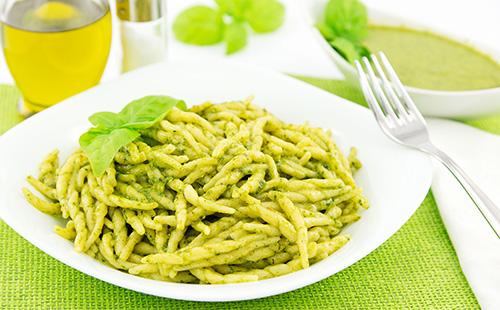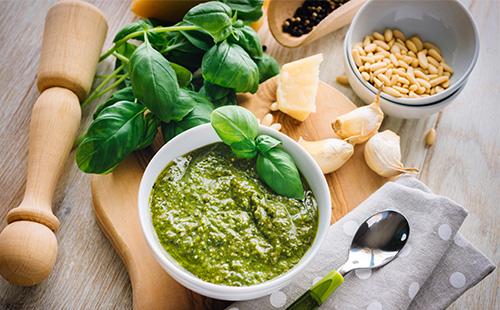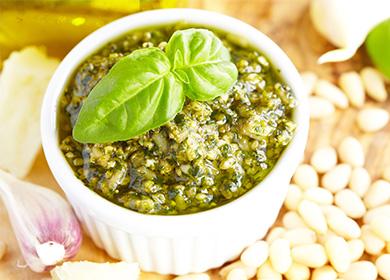Genoa is considered to be the birthplace of pesto genovese. Scientists found that the dish originated in the days of the Roman Empire, but it was only elevated to the rank of national food in the 19th century. Perhaps the name of the sauce sounds complicated for the Russian ear, but in fact, everything is extremely simple: pestare in Italian means "grind". What would it be, you ask. And besides, many years ago, when the blender didn’t exist at all, the housewives rubbed the ingredients for liquid seasoning in a mortar. Today, all adherents of an authentic recipe do the same. The chefs of the world are sure that the porridge-shaped chopping of greens with the help of modern kitchen equipment kills the very spirit of the dish.
Traditional ingredients
The classic recipe for pesto sauce is called Genoese. In the original language, the name of the dish is written as Pesto alla genovese. Authentic, according to the researchers, gravy includes basil grown and lovingly harvested in a suburb of the coastal city, coarse sea salt, pine seeds (a kind of pine) and finely chopped garlic. There is another ingredient, due to which the classic execution of the sauce is considered inaccessible to many hostesses of the planet. This is a hard sheep’s cheese, bought on a small home farm at the foot of Mount Antola. All ingredients of a traditional dish after thoroughly grinding in a mortar are seasoned with Ligurian olive oil. And only the first spin. The Genoese do not use other pesto.
Of course, Italians have other recipes for making their favorite sauce. Moreover, each region boasts its own special method. Here, for example, is Solar Sicily. Local mothers and grandmothers always add tomatoes to the sauce. And the Neapolitans completely threw out sheep’s cheese from the recipe, which is not so easy to get in their region, and supplied them with pesto-dried tomatoes and almonds.
Therefore, in the case of Italian sauce, there is no need to be afraid to experiment. It can be prepared with lemon balm, mint leaves and even dill branches traditional for our places. The main secret is a mortar and extra virgin olive oil.
What is the value. Benefit or harm
The national sauce of Italy is not just delicious, it goes well with many dishes. It is also very useful. Provided that you are preparing a liquid seasoning from homemade products and knowingly confident in their quality. More about the beneficial properties of the main ingredients of the sauce can be found in the table.
Table - Useful properties of the main ingredients of pesto
| Ingredient | Beneficial features |
|---|---|
| Basil | - It has anti-inflammatory effect; - contains flavonoids that affect the elasticity of blood vessels; - rich in tannins that remove toxins; - improves digestion; - relieves stress; - stimulates metabolic processes |
| Pine nuts | - A powerful antioxidant; - strengthen the immune system; - contribute to weight loss; - rich in vitamins K, B1 and E; - a storehouse of iron, potassium and calcium; - regulator of the circulatory system |
| Parmesan | - A storehouse of protein that is easily digested; - contains many tripeptides that reduce blood pressure |
| Olive oil | - Rich in Vitamin E; - contains unsaturated fatty acids; - the most powerful antioxidant; - neutralizes cholesterol; - accelerates metabolic processes |
| Garlic | - Natural antibiotic; - has anti-inflammatory effect; - antibacterial agent; - a stimulator of the stomach |
Homemade Pesto Sauce Recipes
The use of sauce in cooking is a common occurrence. A homemade pesto sauce recipe can include a wide variety of ingredients. It all depends on your preferences and the contents of your refrigerator. Below are the most popular ways to create Italian gravy. Each of them you can cook exactly according to the recipe, or you can supplement it with your own - the author's "highlight".
Green
Feature. The classic of the culinary genre suggests just such a color of sauce - the color of juicy greens, five minutes ago collected from the garden. Green gravy is recommended to season traditional Italian minestrone soup, as well as creamy risotto. Liquid seasoning will perfectly emphasize the taste of any pasta and will be the perfect complement to Caprese - an appetizer made from fresh tomatoes and mozzarella and seasoned with oregano and olive oil.
You will need:
- lemon basil - a bunch;
- pine nuts - three tablespoons;
- sheep cheese - 30 g;
- garlic - two cloves;
- Parmesan - 30 g;
- olive oil - 80 ml;
- salt is optional.
Cooking algorithm
- The recipe for pesto sauce with basil involves the preliminary grinding of two types of cheese on a grater.
- We send garlic, herbs, nuts and chopped cheese into a mortar and again carefully grind the ingredients, mixing them together.
- Slightly salt the almost ready sauce and slowly pour olive oil into it, constantly stirring.
- Ready gravy should have a consistency of 15% sour cream.
Yellow
Feature. Yellow pesto sauce is known primarily for being an integral ingredient in avocado puree soup. But, by and large, you can add to this gravy any first course. Its taste is especially beneficial in pumpkin cream soup, as well as in soups seasoned with fried sesame seeds. For cooking, ricotta cheese and two types of nuts are used - walnuts and cedar. If there is such an opportunity, pine nuts can be replaced with more traditional pinion seeds for Italy.
You will need:
- aromatic basil - half a bunch;
- cedar seeds - three tablespoons;
- walnuts - a tablespoon;
- garlic - a pair of cloves;
- Parmesan - 30 g;
- ricotta - 170 g;
- olive oil - half a cup.
Cooking algorithm
- Using a blender, grind nuts. You can all together, without dividing into varieties.
- Grind the parmesan and grind the ricotta in the same way.
- All ground ingredients, as well as garlic and basil, are carefully ground in a mortar.
- Fill the mixture with vegetable oil until the sour cream is thick.

Red
Feature. If you intend to serve grilled meat or baked vegetables for dinner, red Italian seasoning will be the best addition to this set of dishes. To make red home pesto, you will need sun-dried tomatoes and capers. However, today these ingredients are not a curiosity even for our places. They can be freely purchased at any major supermarket. By the way, red seasoning is especially good for baked eggplant. Be sure to try it.
You will need:
- lemon basil - half a bunch;
- cedar seeds - three tablespoons;
- garlic - two cloves;
- grated parmesan - 50 g;
- sun-dried tomatoes - 80 g;
- balsamic vinegar - a tablespoon;
- salt to taste;
- capers - a tablespoon;
- olive oil - half a cup.
Cooking algorithm
- All the ingredients except balsamic vinegar and capers are sent to the blender bowl and chopped slowly. It is important to set the minimum speed on the kitchen device so that the mixture does not turn into porridge.
- After grinding, add capers and vinegar to a common bowl. Mix.
- Gradually pour olive oil into the base for the sauce until the mixture reaches the desired consistency.
Violet
Feature. Liquid Italian seasoning of violet color is ideally combined with sea fish and other seafood. It is served with mussels and raps, and the Spaniards love to season their traditional paella with this sauce or dip boiled asparagus in it. The seasoning acquires a peculiar color thanks to the purple basil. While in all the previous ones there appears green - the so-called lemon basil. And a special aroma to the dish gives ghee.
You will need:
- arugula - a bunch;
- purple basil - a quarter of the bunch;
- cedar seeds - three tablespoons;
- garlic - two cloves;
- melted butter - a tablespoon;
- olive oil - half a glass;
- lemon juice - half a teaspoon.
Cooking algorithm
- Grind greens with nuts in a blender bowl, setting the minimum speed of the device.
- We heat a piece of butter in a water bath and pour it into the mixture.
- We season the base with olive oil and do not forget to salt to taste.

Russian variant
Feature. Russians are also distinguished by originality. They decided that since parsley is more common in their latitudes, it means that it can be safely replaced with basil and arugula. However, the domestic recipe is no less tasty and harmonious. Well, let the taste be a little different. The main secret is in grinding the ingredients and vegetable oil. But only olive and exclusively first spin. The recipe for green parsley pesto sauce is more creamy. In addition, for our brother, the taste of parsley is more familiar and dearer. While not everyone likes the specific taste and aroma of basil. You will not surprise a housewife with walnuts either, therefore, the use of cedar seeds in the national recipe is used less often.
You will need:
- parsley - a large bunch;
- mint - half a bunch;
- creamy cheese - 100 g;
- lemon - half;
- garlic - two cloves;
- coarse sea salt - to taste;
- olive oil - for thickening;
- walnuts - a quarter cup.
Cooking algorithm
- Thoroughly wash the herbs and mint and spread on paper napkins until completely dry.
- We chop the green ingredients of the dish with a knife and put them in the blender bowl.
- Add the nuts there and grind the ingredients at a slow speed.
- After we send the cream cheese into the bowl, squeeze out the juice of half a lemon and salt to taste.
- Stir, introduce vegetable oil to obtain the desired consistency and serve.
What is combined with
If you ask an Italian what they eat pesto with, they will round their eyes and smile. The creators of the famous green seasoning add it to any dish - and in meat, and fish, and in the "naked" pasta. They eat pesto for breakfast, spreading the sauce on toasts or dipping hot oven cakes in it.
- With meat. Any meat dish seasoned with a creamy sauce gains piquancy.And the light aftertaste that the nuts leave only fuels an already flaming appetite.
- With fish. Fish dishes are light and fresh. Italian sauce makes them more nutritious and interesting to taste.
- With pizza. Italians have such a thing as green pizza. In fact, this is the most ordinary pizza - a tortilla stuffed with all sorts of stuff. Only before laying out the filling, a thin layer of dough must be greased with a Genoese mixture. It turns out well, very aromatic and appetizing.
- With mashed potatoes. For dressing mashed potatoes you will need a thicker and thicker sauce than, for example, for pasta or bread spread. By the way, in a similar way you can season celery puree and chickpea puree.
- With salty pastries. Adding pesto to pastries is a purely Italian tradition, however, it has long been elevated to the rank of international. A few tablespoons of aromatic sauce is not a sin to add to the dough for baking fettuccine, fritters, homemade bread or puff pastries with meat, vegetable or fish filling.

Note to the cook
Each Italian mistress has her own secret to making pesto, from which her family goes crazy. Few people share culinary secrets, but still managed to try out some from the mothers and grandmothers of the sunny country. Take a look at the following eight recommendations.
- The temperature of the ingredients. Pesto is one of the few liquid seasonings that does not need heat treatment. Cooking, steaming or frying the ingredients is not necessary. It is enough just to grind them with each other in the same bowl. But it is imperative that each element of the dish has approximately the same temperature as the other elements. Therefore, before starting cooking, it is worth taking out all the ingredients from the refrigerator and letting them reach room temperature.
- Nuts for every taste. Replace the seeds of pine or cedar with any other nuts. Even pistachios or cashews. This is a fertile land for experimentation. After all, it seems like a step-by-step recipe for pesto sauce is the same, and the taste of the dish is already completely different.
- Parmesan is a priority. Parmesan is considered one of those ingredients in which there is no alternative in liquid seasoning. This cheese adds spice to the dish. But if you can’t find it, or you can’t afford to buy such cheese, you can take any hard one. However, at the end, the sauce will have to be slightly salted.
- For bread - one, for pasta - another. The consistency of the dish depends on your intentions regarding its future use. For example, a paste with a thinner sauce can be served. But on bread it is more convenient to spread the seasoning thicker. Consider this when cooking and, if necessary, add a little more oil.
- Oxidation of basil. It is important to know that basil, having touched the metal, is oxidized right now. Therefore, choosing this ingredient as the basis of liquid seasoning, it is better to grind it with a mortar and pestle.
- Harvesting for the winter. In the cold season, finding basil in the store is not an easy task. If you love pesto in the same way that Italians love it, do the following. Prepare the sauce in summer or autumn, pour it into ice tins and freeze. Having taken out the form from the freezer, you will have a lot of portioned pieces of iced seasoning.
- No ice cream basil. Some housewives who do not know the secrets of freezing sauce will freeze basil for the future. Unfortunately, thawed basil loses its former elasticity of the leaves, and the taste with aroma disappears somewhere. Therefore, freezing grass is not a way out.
- Shelf life. Home-made Italian seasoning can be stored in the refrigerator for up to two weeks. If it is vital for you to keep the dish fresh as long as possible, fill the finished sauce with vegetable oil (similar to what you used to dress), cover with a nylon cover and send to the refrigerator door.
Of course, you can especially not bother and bring a can of your favorite sauce from the store. But under the industrial cover is not what the soul desires. Instead of expensive olive, manufacturers add sunflower oil to the dish.Fragrant cedar seeds are replaced with budget cashew nuts. For long-term storage, preservatives are introduced into the composition of the seasoning, which allergies are so afraid of. And as a thickener, harmful glucose-based syrup is used.
For a creative person, preparing pesto sauce is a pleasure. Seasoning is combined with many dishes familiar to our country and adds some kind of “zest” to everyone. Sauce is the mood of your culinary masterpiece. And it depends only on you how it will be today: playful and light, gentle, mischievous or with a slyness.
Reviews: “My secret is cilantro and some ground pepper”
The sauce turned out to be just a meal. It can be eaten even without an addition to anything. He is satisfying thanks to nuts and cheese. Frankly, I added some cilantro greens and some ground pepper to the basil, but this did not ruin the taste of this wonderful sauce.
Tanusha, https://webspoon.ru/receipt/sous-pesto
Well, I tried it, now I will always make pesto sauce, the whole family really liked it. I made it with pine nuts, that is, I broke it, but then I will try with other nuts, otherwise it’s expensive. And my parmesan is not very expensive, I buy ready-made powder in bags of 100 rubles, add to salads, now I’ll be here.
Example Gulnara, http://volshebnaya-eda.ru/kollekcia-receptov/sousy/pesto/#ixzz4w2FvV2ue
The sauce was just wonderful, you’ll lick your fingers! Just be careful with peeled pine nuts! After consumption, bitterness in the mouth may occur, which will last several days. I am already tormented for the second day.
Kirrra, https://gotovim-doma.ru/recipe/597-sous-pesto
Pesto is just a pasty sauce that is not boiled. Typically, the components are wiped in a mortar or mixer. Genoese - the most famous consists of basil (there is fresh, but I think it can be dried), parmesan (and / or pecorino), olive oil, salt, garlic and pine nuts (can be fried, or maybe it is necessary?). There are some modern options seem with pumpkin oil + pumpkin seeds. Pink pestle: dried tomatoes + hot peppers + cheese + salt + olive oil. In general, you can certainly experiment, and come up with something from the available products.
Lovely http://www.woman.ru/home/culinary/thread/3547583/

